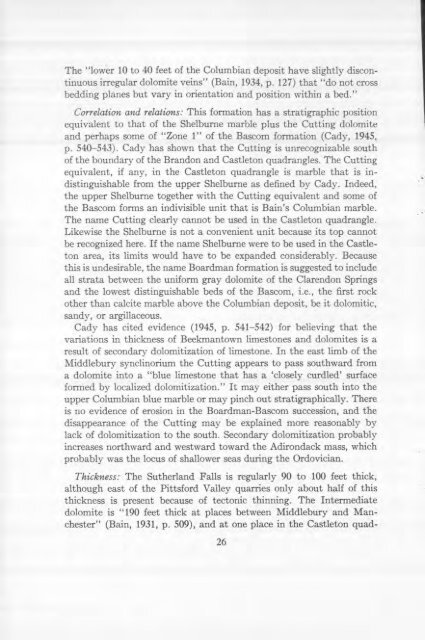STRATIGRAPHY AND STRUCTURE CASTLETON AREA VERMONT
STRATIGRAPHY AND STRUCTURE CASTLETON AREA VERMONT
STRATIGRAPHY AND STRUCTURE CASTLETON AREA VERMONT
You also want an ePaper? Increase the reach of your titles
YUMPU automatically turns print PDFs into web optimized ePapers that Google loves.
The "lower 10 to 40 feet of the Columbian deposit have slightly discontinuous<br />
irregular dolomite veins" (Bain, 1934, p. 127) that "do not cross<br />
bedding planes but vary in orientation and position within a bed."<br />
Correlation and relations: This formation has a stratigraphic position<br />
equivalent to that of the Shelburne marble plus the Cutting dolomite<br />
and perhaps some of "Zone 1" of the Bascom formation (Cady, 1945,<br />
p. 540-543). Cady has shown that the Cutting is unrecognizable south<br />
of the boundary of the Brandon and Castleton quadrangles. The Cutting<br />
equivalent, if any, in the Castleton quadrangle is marble that is indistinguishable<br />
from the upper Shelburne as defined by Cady. Indeed,<br />
the upper Shelburne together with the Cutting equivalent and some of<br />
the Bascom forms an indivisible unit that is Bain's Columbian marble.<br />
The name Cutting clearly cannot be used in the Castleton quadrangle.<br />
Likewise the Shelburne is not a convenient unit because its top cannot<br />
be recognized here. If the name Shelburne were to be used in the Castleton<br />
area, its limits would have to be expanded considerably. Because<br />
this is undesirable, the name Boardman formation is suggested to include<br />
all strata between the uniform gray dolomite of the Clarendon Springs<br />
and the lowest distinguishable beds of the Bascom, i.e., the first rock<br />
other than calcite marble above the Columbian deposit, be it dolomitic,<br />
sandy, or argillaceous.<br />
Cady has cited evidence (1945, p. 541-542) for believing that the<br />
variations in thickness of Beekmantown limestones and dolomites is a<br />
result of secondary dolomitization of limestone. In the east limb of the<br />
Middlebury synclinorium the Cutting appears to pass southward from<br />
a dolomite into a "blue limestone that has a 'closely curdled' surface<br />
formed by localized dolomitization." It may either pass south into the<br />
upper Columbian blue marble or may pinch out stratigraphically. There<br />
is no evidence of erosion in the Boardman-Bascom succession, and the<br />
disappearance of the Cutting may be explained more reasonably by<br />
lack of dolomitization to the south. Secondary dolomitization probably<br />
increases northward and westward toward the Adirondack mass, which<br />
probably was the locus of shallower seas during the Ordovician.<br />
Thickness: The Sutherland Falls is regularly 90 to 100 feet thick,<br />
although east of the Pittsford Valley quarries only about half of this<br />
thickness is present because of tectonic thinning. The Intermediate<br />
dolomite is "190 feet thick at places between Middlebury and Manchester"<br />
(Bain, 1931, p. 509), and at one place in the Castleton quad-<br />
26













